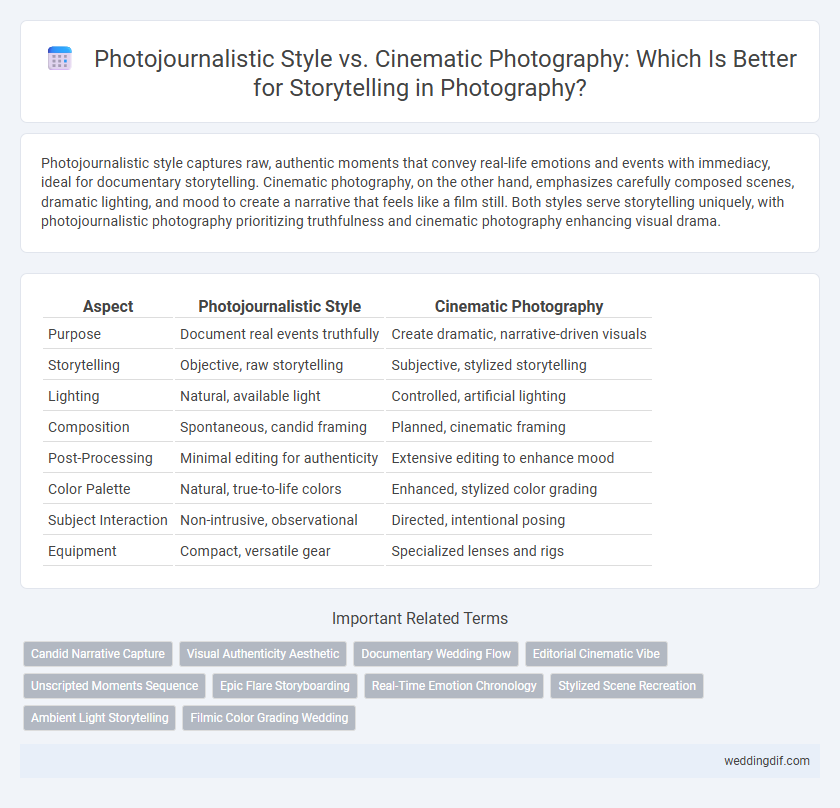Photojournalistic style captures raw, authentic moments that convey real-life emotions and events with immediacy, ideal for documentary storytelling. Cinematic photography, on the other hand, emphasizes carefully composed scenes, dramatic lighting, and mood to create a narrative that feels like a film still. Both styles serve storytelling uniquely, with photojournalistic photography prioritizing truthfulness and cinematic photography enhancing visual drama.
Table of Comparison
| Aspect | Photojournalistic Style | Cinematic Photography |
|---|---|---|
| Purpose | Document real events truthfully | Create dramatic, narrative-driven visuals |
| Storytelling | Objective, raw storytelling | Subjective, stylized storytelling |
| Lighting | Natural, available light | Controlled, artificial lighting |
| Composition | Spontaneous, candid framing | Planned, cinematic framing |
| Post-Processing | Minimal editing for authenticity | Extensive editing to enhance mood |
| Color Palette | Natural, true-to-life colors | Enhanced, stylized color grading |
| Subject Interaction | Non-intrusive, observational | Directed, intentional posing |
| Equipment | Compact, versatile gear | Specialized lenses and rigs |
Introduction to Storytelling in Wedding Photography
Photojournalistic style in wedding photography captures raw, candid moments that authentically convey emotions and unfolding stories without interference. Cinematic photography employs dramatic lighting, composition, and post-processing techniques to create visually striking, storytelling images with a narrative flair. Both approaches enhance storytelling by offering distinct perspectives: photojournalistic style emphasizes real-life spontaneity, while cinematic style creates stylized scenes that evoke mood and drama.
Defining Photojournalistic Wedding Photography
Photojournalistic wedding photography captures candid, unposed moments that authentically document the day's emotions and events, emphasizing natural light and real-time storytelling over staged setups. This style prioritizes emotional truth and narrative flow, contrasting with cinematic photography's stylized composition, dramatic lighting, and often scripted scenes. By focusing on genuine interactions and spontaneous expressions, photojournalistic wedding photography creates a visual narrative that feels intimate and timeless.
Understanding Cinematic Wedding Photography
Cinematic wedding photography captures moments with dramatic lighting, wide-angle shots, and carefully composed scenes that evoke the feeling of a film narrative, emphasizing emotion and atmosphere. Unlike photojournalistic style, which documents events candidly and chronologically, cinematic photography blends artistic direction with real moments to create a visually striking story. This approach enhances storytelling by using techniques such as controlled depth of field, color grading, and dynamic angles to immerse viewers in the wedding's unique ambiance.
Key Differences: Photojournalistic vs. Cinematic Approaches
Photojournalistic photography captures authentic, real-time moments with an emphasis on truth and context, prioritizing spontaneity and minimal manipulation to convey a story. Cinematic photography, by contrast, employs deliberate composition, lighting, and post-processing techniques to create stylized, dramatic imagery that mimics film aesthetics for immersive storytelling. The photojournalistic approach relies on raw, unposed scenes while cinematic photography orchestrates visual elements to evoke emotion and narrative depth.
Capturing Real Moments: The Appeal of Photojournalism
Photojournalistic style emphasizes capturing authentic, unposed moments that convey genuine emotions and narratives, making it highly effective for storytelling. This approach prioritizes spontaneity and contextual relevance, allowing viewers to connect deeply with the subject's reality. Unlike cinematic photography, which often involves staged scenes and dramatic lighting, photojournalism relies on natural settings and real-time events to preserve the integrity of the story.
Creating Visual Drama: Cinematic Photography Techniques
Cinematic photography creates visual drama through techniques like controlled lighting, dynamic compositions, and color grading that mimic film aesthetics. It emphasizes mood and atmosphere by using shallow depth of field and dramatic shadows, enhancing narrative impact. Photojournalistic style captures raw, real-life moments without manipulation, focusing on authenticity rather than constructed scenes.
Storytelling Impact: Which Style Tells Your Love Story Best?
Photojournalistic style captures raw, candid moments that convey authentic emotions and unfiltered narratives, ideal for telling a genuine love story with real-time spontaneity. Cinematic photography uses dramatic lighting, composition, and post-processing to craft visually striking, emotionally charged scenes that elevate your love story to a cinematic experience. Choosing between these styles depends on whether you prefer heartfelt realism or artistic dramatization to tell your unique love story.
Editing Styles: Natural vs. Artistic Enhancements
Photojournalistic style emphasizes natural editing techniques to preserve authenticity and capture real moments, maintaining true-to-life colors and minimal retouching. Cinematic photography employs artistic enhancements such as dramatic color grading, contrast adjustments, and stylized filters to evoke specific moods and narratives. The choice between these editing styles significantly impacts the storytelling approach, either grounding the story in reality or creating a visually crafted atmosphere.
Choosing the Right Photographer for Your Wedding Story
Selecting the right photographer for your wedding story involves understanding the distinction between photojournalistic style and cinematic photography, each offering unique storytelling techniques. Photojournalistic style captures authentic, candid moments as they naturally unfold, emphasizing emotional truth and spontaneity without posed shots. Cinematic photography creates visually striking, dramatic images inspired by film, using controlled lighting and composition to craft a narrative with mood and atmosphere.
Final Thoughts: Blending Styles for Unique Storytelling
Blending photojournalistic style and cinematic photography creates a powerful narrative by combining raw authenticity with dramatic visual storytelling. Utilizing the spontaneity and real-life moments of photojournalism alongside the controlled composition and lighting of cinematic techniques enhances emotional depth and engagement. This fusion allows photographers to deliver unique stories that resonate more profoundly with audiences and stand out in visual storytelling.
Photojournalistic Style vs Cinematic Photography for storytelling. Infographic

 weddingdif.com
weddingdif.com